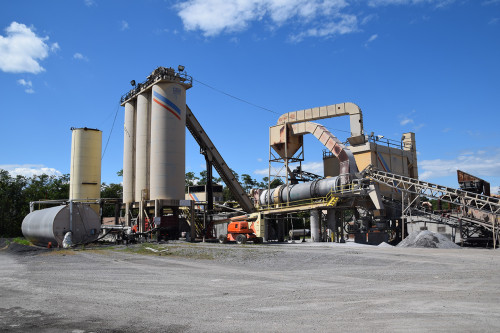Experience the Difference: Hot Mix Asphalt Paving for Regrading Projects
Experience the Difference: Hot Mix Asphalt Paving for Regrading Projects
Blog Article
Unlocking the Tricks of Warm Mix Asphalt Innovation
Discovering the depths of hot mix asphalt innovation discovers a world where meticulous processes and specific solutions merge to form our roadways and facilities. The combination of accumulations, binders, and fillers isn't just a building and construction job however a tactical orchestration of durability and efficiency. As we peer right into the complex dance of components, a tapestry of resilience and sustainability unravels. However what lies beneath this surface of asphaltic proficiency, and what tricks wait to be revealed in the realm of leading advancements?
Relevance of Hot Mix Asphalt
Warm Mix Asphalt plays an important role in contemporary framework advancement as a result of its toughness and cost-effectiveness. As the most typically made use of paving product for roadways, highways, and parking area, Warm Mix Asphalt provides a series of advantages that add to its significance in building and construction projects. One crucial benefit is its ability to stand up to rush hour lots and rough weather conditions, giving a trustworthy and durable surface for transport networks. In Addition, Warm Mix Asphalt is cost-effective in both preliminary building and lasting upkeep, making it a favored choice for numerous facilities jobs.
The durability of Warm Mix Asphalt stems from its make-up, which consists of aggregates, binder, and filler materials that are carefully picked and mixed to fulfill particular performance demands. Overall, the importance of Warm Mix Asphalt in framework development can not be underrated, as it continues to be a keystone of contemporary building and construction methods.
Elements of Asphalt Mixes
The structure of asphalt mixes is composed of meticulously chosen accumulations, binder, and filler materials that are essential for attaining specific efficiency requirements. Accumulations are the key element of asphalt blends, providing stamina and security. These aggregates can be natural, such as gravel or crushed stone, or artificial, like recycled materials from old pavements. The binder, commonly asphalt or asphalt cement, holds the aggregates with each other and provides versatility and durability to the mix. The selection of the binder is vital as it straight influences the mix's performance in various weather. Fillers, such as moisturized lime or Portland concrete, are made use of to improve the mix's workability and aging resistance. Angled Parking.
The mix and percentage of these elements play a substantial role in establishing the top quality and efficiency of the asphalt mix. Designers very carefully make the mix to fulfill certain demands, thinking about elements like web traffic volume, climate conditions, and pavement lifespan. Proper selection and harmonizing of accumulations, binder, and fillers are necessary for creating resilient, durable asphalt sidewalks.
Combining and Production Techniques

Once the aggregates are selected, the binder, commonly asphalt concrete, is included in bind the products with each other. The binder's high quality and quantity substantially affect the mix's more information flexibility, resistance, and toughness to environmental factors. In addition, fillers like moisturized lime or Portland cement might be included to improve particular qualities of the asphalt mix, such as its workability or moisture resistance.
Throughout manufacturing, the aggregates and binder are warmed, commonly between 250-325 ° redirected here F(121-163 ° C ), to facilitate blending and make sure proper coating of the accumulations. The mixing process has to be complete to accomplish a homogeneous blend that advertises the wanted performance features of the asphalt. Different techniques, such as set mixing or drum blending, are employed to attain premium and regular asphalt mixes for building and construction jobs.
Factors Affecting Asphalt Performance
Aspects affecting asphalt performance encompass a variety of variables that affect the resilience, durability, and total quality of asphalt pavements. One crucial variable is the top quality of materials used in the asphalt mix.

Style factors to consider, such as sidewalk density and water drainage, are essential in ensuring the long-lasting efficiency of the asphalt sidewalk. By meticulously considering these engineers, professionals and elements can maximize asphalt efficiency and improve the service life of sidewalks.
Lasting Practices in Asphalt Technology

Furthermore, the development of warm-mix asphalt (WMA) technologies has actually gotten traction in the last few years. WMA permits the production and placement of asphalt blends at lower temperatures contrasted to traditional hot-mix asphalt, resulting in lowered energy consumption and greenhouse gas exhausts. The usage of porous asphalt blends can help minimize stormwater overflow issues by enabling water to infiltrate via the sidewalk and into the ground, advertising natural water purification and charge procedures. By executing these sustainable methods, the asphalt industry can add to constructing a more eco-friendly and resistant facilities network.
Conclusion
To conclude, hot mix asphalt innovation plays a crucial role in modern infrastructure development because of its durability and cost-effectiveness. By carefully balancing components, employing proper blending strategies, and taking into consideration numerous variables, designers can create high-quality asphalt blends that withstand rush hour lots and extreme climate condition. Accepting sustainable techniques, such as making use of warm-mix innovations and recycled materials, even more enhances the environmental friendliness of asphalt modern technology.
Blending and production techniques in warm mix asphalt innovation involve the specific mix and processing of accumulations, binder, and fillers to produce a long lasting and high-performance asphalt mix.Factors affecting asphalt performance incorporate a variety of variables that impact the durability, long life, and overall top quality of visit this site asphalt sidewalks. Sustainable methods in asphalt technology incorporate different initiatives intended at minimizing the environmental effect of asphalt production and paving procedures. By incorporating redeemed asphalt pavement (RAP) and recycled asphalt tiles (RAS) into brand-new asphalt mixes, the market can considerably lower the consumption of raw materials and power, while also reducing land fill waste.
WMA enables for the manufacturing and placement of asphalt blends at reduced temperatures contrasted to traditional hot-mix asphalt, resulting in minimized power consumption and greenhouse gas exhausts.
Report this page